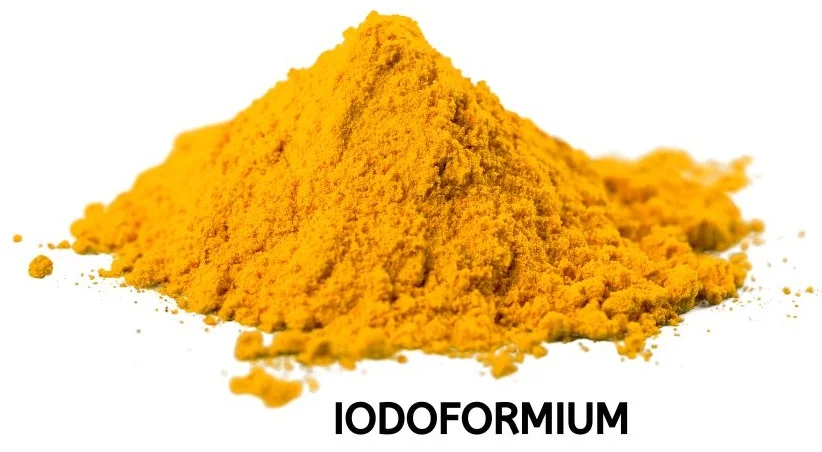Iodoform (Iodoformum) is a homeopathic remedy derived from triiodomethane, a compound with antiseptic properties.
It has been widely used in homeopathy for treating tubercular conditions, particularly in cases of tubercular meningitis, chronic diarrhoea in children, and respiratory conditions such as asthma, cough, and wheezing.
The remedy works well for individuals who show signs of weakness, neurological issues, and gastrointestinal disturbances, often linked to tuberculosis.

Table of Contents
ToggleSOURCE INFORMATION
Scientific Classification
- Class: Organic Compound
- Family: Halomethanes
- Formula: CHI₃ (Triiodomethane)
Origin
- Iodoform is a yellow, crystalline organic compound with a distinct odour.
- It was discovered in the early 19th century and was widely used as a disinfectant in surgeries due to its antiseptic properties.
- Over time, it was incorporated into homeopathy for conditions like tuberculosis and chronic respiratory and digestive disorders.
Historical Facts
- Iodoform was first prepared in 1822 by French chemist Georges-Simon Serullas.
- Historically, it was used in mainstream medicine as a wound dressing due to its antimicrobial properties.
- In homeopathy, it was introduced primarily for its effectiveness in tuberculosis and respiratory ailments.
DRUG PATHOGENESIS
- Iodoform’s action revolves around its antiseptic and antimicrobial properties, influencing the respiratory, gastrointestinal, and neurological systems.
- Its main pathogenesis is its role in fighting tubercular infections, reducing chronic inflammation, and addressing nervous exhaustion and respiratory distress.
- It helps alleviate symptoms in individuals suffering from a tubercular constitution or chronic digestive issues related to malnutrition.
PHYSICAL CONSTITUTION
Iodoform is suitable for individuals who are:
- Physically weak, often with a wasting appearance.
- Suffering from tubercular or chronic ailments.
- Prone to respiratory issues, digestive disturbances, and mental exhaustion.
DIATHESIS
- Tubercular Diathesis: Individuals with a tendency toward tuberculosis and chronic respiratory and digestive issues.
- Weak, fragile constitutions: Those who frequently fall ill, with long recovery periods and susceptibility to infections.
TEMPERAMENTS
- Melancholic: The remedy often fits individuals who feel depressed, anxious, and fearful.
- Sensitive: These individuals may also be highly sensitive to cold, easily fatigued, and feel overwhelmed by physical and emotional stress.
KEY CHARACTERISTICS
- Respiratory Distress: Asthmatic breathing, wheezing, and cough at night.
- Tubercular Conditions: Especially effective in tubercular meningitis, chronic cough, and chronic diarrhoea.
- Weakness: Significant weakness in limbs, making it difficult for patients to stand or walk.
- Digestive Issues: Scaphoid abdomen, distension, and chronic diarrhoea with greenish stools.
DETAILED ORGAN SYMPTOMS
HEAD
- Sharp neuralgic pain: Occasional shooting pain in the head.
- Heavy head: Feeling as if the head is too heavy to lift from the pillow.
- Meningitis: Useful in treating tubercular meningitis.
- Sleep disturbances: Interrupted sleep with sighing and cries, followed by extreme drowsiness.
EYES
- Pupils dilated, reacting poorly to light.
- Diplopia (double vision) and failing sight caused by retro-bulbar neuritis.
- Scotoma: Partial loss of vision due to damage to the optic disc.
CHEST
- Sore pain in the apex of the right lung.
- Weight on the chest with a smothering sensation.
- Cough and wheezing, especially on going to bed.
- Pain in the left breast, described as feeling like a hand grasping the heart.
- Asthmatic breathing with difficulty in drawing a deep breath.
ABDOMEN
- Scaphoid abdomen (sunken in appearance) with chronic diarrhoea.
- Stools are greenish, watery, and undigested.
- Mesenteric glands are enlarged, indicating a tendency toward tuberculosis.
EXTREMITIES
- Weak legs, especially when trying to stand or walk with eyes closed.
- Weak knees, making it difficult to climb stairs.
MODALITIES
- Worse: At night, lying down, and when trying to sleep.
- Better: Applying local remedies to the head or using the remedy internally for tubercular conditions.
WHAT ARE MODALITIES IN HOMOEOPATHY?
RELATIONSHIP WITH OTHER DRUGS
Complementary Remedies
- BACILLINUM: Works well with Iodoform for treating tuberculosis.
- ARSENICUM and PHOSPHORUS for general weakness and respiratory issues.
Similar Remedies
- BACILLINUM for tubercular tendencies.
- TEREBINTHINA for violet-smelling urine.
DOSE
- Second trituration is recommended.
- For asthmatic breathing, three grains on the back of the tongue can relieve symptoms.
Frequently Asked Questions (FAQs)
What is Iodoform used for in homeopathy?
- Iodoform is mainly used for treating tubercular conditions, respiratory issues like asthma and wheezing, and chronic diarrhoea in children.
How is Iodoform applied?
- Iodoform can be used both internally and externally, particularly in treating tubercular meningitis when applied locally to the head.
What are the main symptoms indicating Iodoform?
- Common symptoms include asthmatic breathing, sharp neuralgic head pain, weakness in the limbs, and chronic diarrhoea with greenish stools.
Can Iodoform be used for respiratory problems?
- Yes, Iodoform is highly effective in treating respiratory issues like asthma, wheezing, and chronic cough.
Glossary
- Tubercular: Related to or characterized by tuberculosis.
- Neuralgic: Sharp, stabbing pain due to irritated nerves.
- Diplopia: Double vision.
- Scaphoid abdomen: A condition where the abdomen appears sunken.
- Haemoptysis: Coughing up blood.
- Retro-bulbar neuritis: Inflammation of the optic nerve behind the eyeball.
- Mesenteric glands: Lymph nodes in the abdomen that can become swollen in certain diseases like tuberculosis.
This information provides a comprehensive overview of Iodoformum’s use in homeopathy for treating a variety of conditions.
